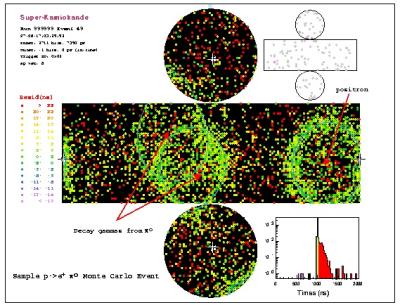
The stability of the proton represents one of the greatest theoretical and experimental challenges in particle physics today. In most grand unified theories, particularly those with a TeV intermediate mass scale, the proton “wants” to decay. Experimentally, however, the proton seems determined to outlive us all. Beginning with the first large-scale searches in the 1980’s, one promising theory after another has floundered on the shoals of nucleon decay. To date, no hint of a nucleon decay signal has emerged.
In spite of this, the study of nucleon decay provides one of the few approaches to the problem of confronting grand unified theories with experimental data, and any progress toward this goal has unique value for the future development of physics. This program has already been a success. The simplest unification model, minimal SU(5), has been ruled out by the experimental results. Every subsequent grand unification theory will remain only a mathematical construct if further experimental information is not available.
The search for nucleon decay requires massive detectors. A search with a sensitivity of 1033 years, for example, requires a detector with approximately 1033 nucleons. Since there are 6 × 1029 nucleons per ton of material, this implies detectors of multi-kiloton scale.
The “classical” proton decay mode, p → e+ π0, can be efficiently detected with low background. At present, the best limit on this mode (τ/β > 1.6 × 1034 yr, 90% CL) comes from a 0.306 megaton-yr exposure of Super-Kamiokande. The detection efficiency of 45% is dominated by final-state π0 absorption or charge-exchange in the nucleus, and the expected background is 2 events/Mton-yr.
Supersymmetric theories favor the mode p → νK+, which is experimentally more difficult due to the unobservable neutrino. The present limit from Super-Kamiokande is the result of combining several channels, the most sensitive of which is K+ → μ+ν accompanied by a de-excitation signature from the remnant 15N nucleus. Monte Carlo studies suggest that this mode should remain background free for the foreseeable future. The present combined limit is τ/β > 5.9 × 1033yr (90% CL) from a 0.260 megaton-yr exposure..
Recent theoretical work suggests that if super-symmetric SO(10) provides the framework for grand-unification, the proton lifetime (into the favored νK+ decay mode) must lie within about one order of magnitude of present limits. Similarly, SO(10) theories suggest τ/β(eπ0) ≈ 1035 years—about a factor of ten beyond the present limit. Thus, continued progress in the search for nucleon decay inevitably requires larger detectors.
Moreover, the enormous mass and exposure required to improve significantly on existing limits (and the unknowable prospects for positive detection) underline the importance of any future experiment’s ability to address other important physics questions while waiting for the proton to decay. Proton decay experiments have made fundamental contributions to neutrino physics and particle astrophysics in the past, and any future experiment must be prepared to do the same. (Last update: 2018/04/27)
Links
Members
File does not exist.






